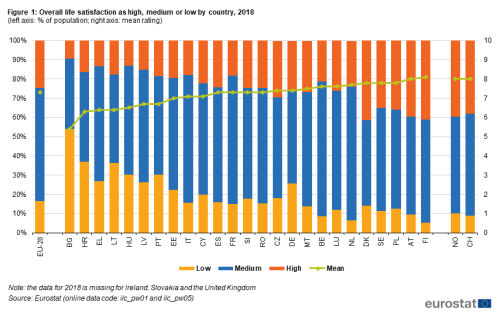Archive:Key figures on the changes in the labour market
Data extracted in Month YYYY
Planned article update: Month YYYY
Highlights
Tweet Text
Tweet Text
<Interactive graph to be set by unit B4:>
or
or
The economic winding down due to the COVID-19 pandemic has hit the economic activity and therefore the labour market. It visibly prejudiced employment but also moved out people from unemployment by affecting their availability or the job search.
This article aims at providing an overview of the last changes in the labour market, looking simultaneously at the development with respect to employment, the unmet demand for employment (i.e. the slack) and people who are neither employed, available to work nor seeking. All three categories together refer to the entire population. As regards the slack, it refers to the whole potential demand for employment. More precisely, the groups constituting the labour market slack are the following:
- unemployed people (fulfilling the three requirements expressed by the International Labour Office (ILO) which are the availability to work, searching for work and not being employed)
- underemployed part-time workers (those part-time workers who wish to work more)
- so-called additional potential labour force as they are not unemployed but either they are available to work and want to but do not search or they search without being immediately available.
This article is based on quarterly and seasonally adjusted Labour Force Survey (LFS) data and investigates the impact of the COVID-19 crisis on the entire population aged 15-74. Both the European and the country approaches are presented in this article, which shows the effect of the COVID-19 crisis at the EU level and at the national level in the respective Member States as well as in the EFTA countries and candidate countries.
This article is part of the online publication Labour market in the light of the COVID 19 pandemic - quarterly statistics alongside the articles Employment, Absences from work and Hours of work.
Direct access to
Main tables
- Title(s) of second level folder (if any)
- Title(s) of third level folder (if any)
Database
- Title(s) of second level folder (if any)
- Title(s) of third level folder (if any)
Dedicated section
Publications
Publications in Statistics Explained (either online publications or Statistical articles) should be in 'See also' above
Methodology
<link to ESMS file, methodological publications, survey manuals, etc.>
- Crime and criminal justice (ESMS metadata file — crim_esms)
- Title of the publication
Legislation
- Use Eur-Lex icon on the ribbon tool at the top of the statistical article to enter the year and reference of your regulation or directive.
- See example of what should be issued hereafter
- Regulation (EU) No 1013/2016
Visualisations
- Regional Statistics Illustrated - select statistical domain 'xxx' (= Agriculture, Economy, Education, Health, Information society, Labour market, Population, Science and technology, Tourism or Transport) (top right)
External links
Notes
<footnote text will be automatically inserted if reference tags are used in article content text (use reference icon on ribbon)>
[[Category:<Subtheme category name(s)>|Name of the statistical article]] [[Category:<Statistical article>|Name of the statistical article]]
Delete [[Category:Model|]] below (and this line as well) before saving!
